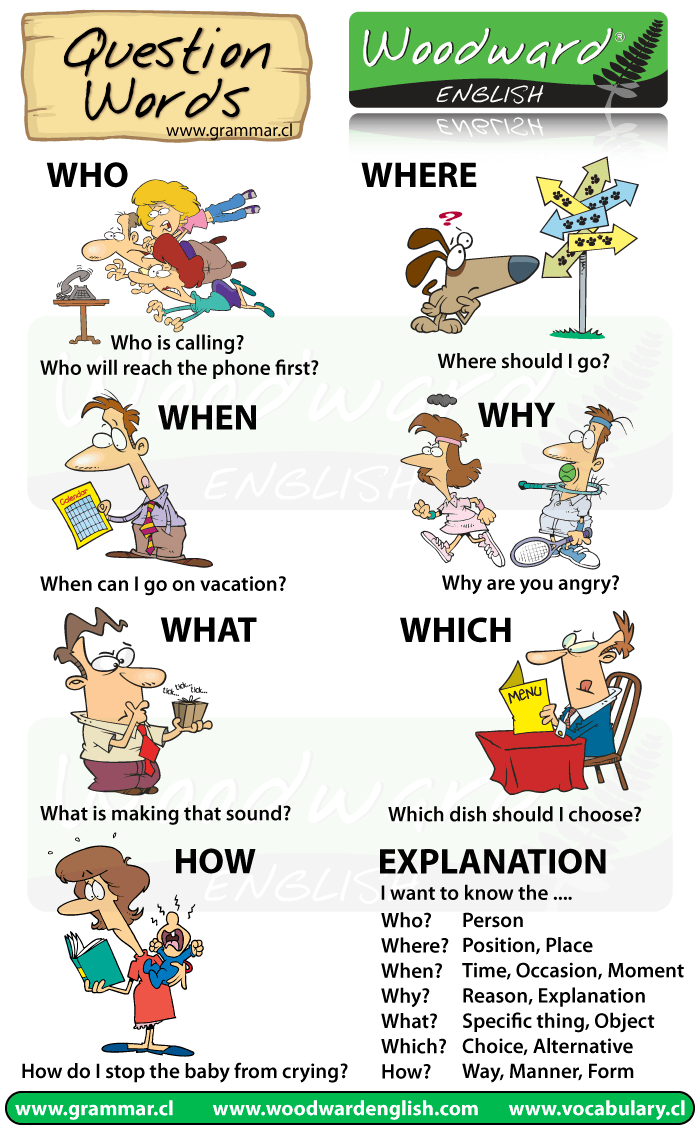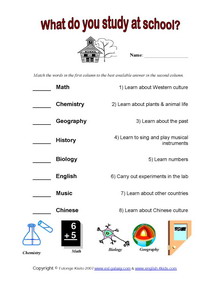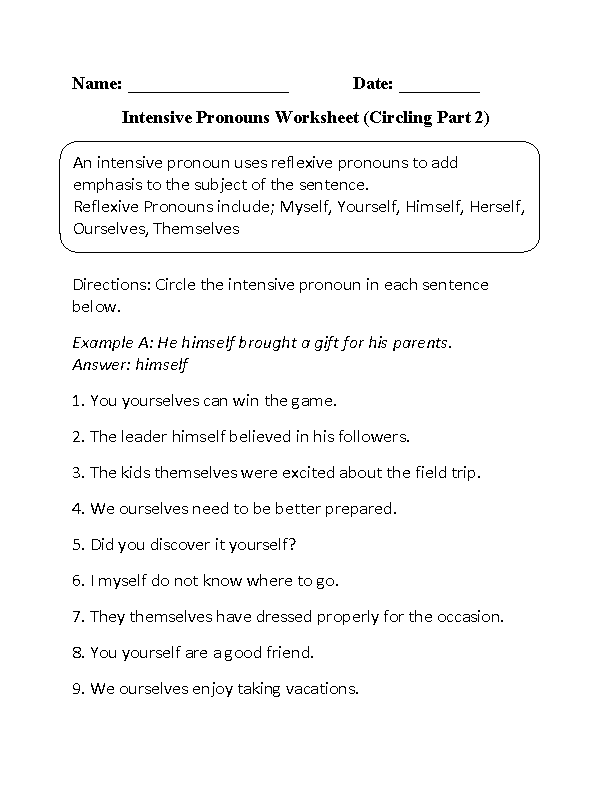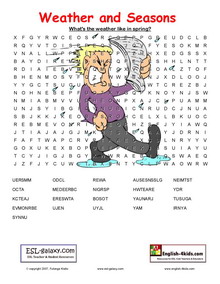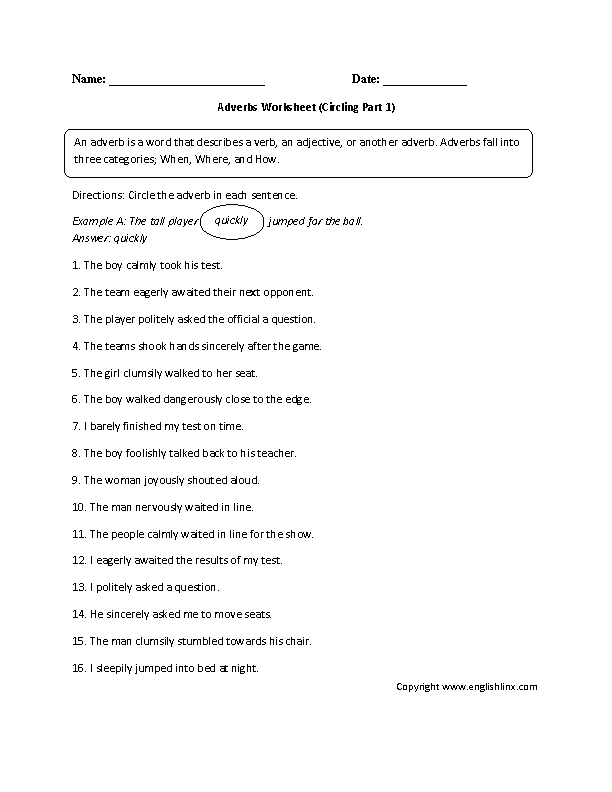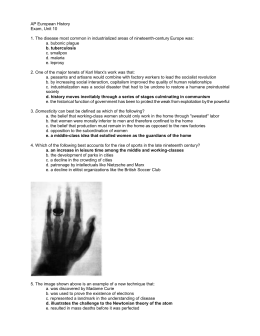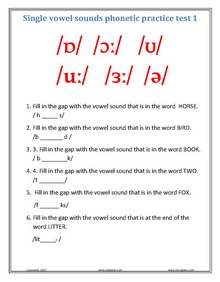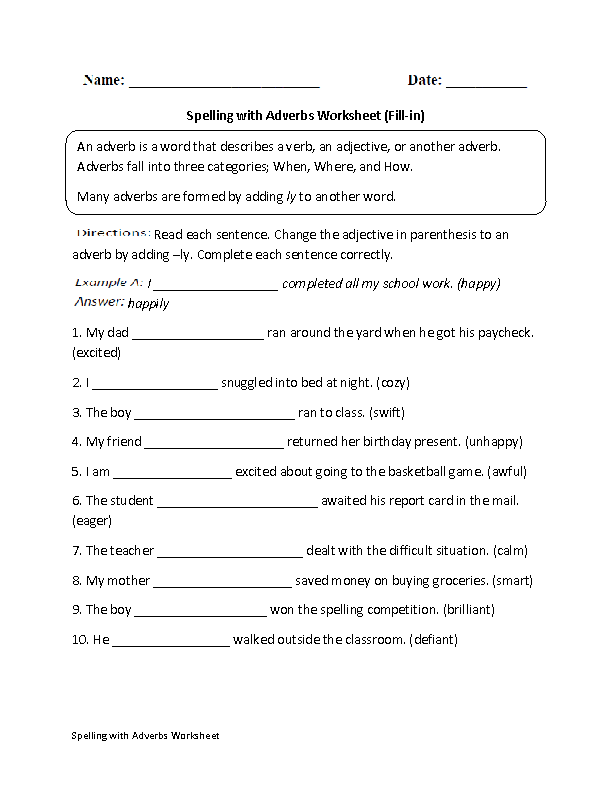Relative adverbs act as subjects or objects inside relative clauses, and at the same time they connect relative clauses to nouns or pronouns in other clauses rather like conjunctions. Notes The relative adverb when can be replaced by inon which. RELATIVE PRONOUNS Relative Pronouns introduce relative clauses. Relative clauses are of two kinds: Defining and Nondefining. The relative adverbs when, where and why are used to replace a preposition the relative pronoun which. When replaces in on which, used for time. Improve your language arts knowledge with free questions in Use relative adverbs and thousands of other language arts skills. Distribute the sentence fragments and relative pronouns to pairs of students, small groups, or individuals. Challenge students to create sentences with the sentence fragments. For students who need extra support, provide the two clauses and have students fill in the missing relative pronoun. Relative pronouns By antonella8 The above downloadable teaching material is a great resource for high school students elementary school students and adults at Preinterm Relative pronouns are words like who, whom, whose, which and that. Sometimes the words what, when, where and why are also used like relative pronouns. Complete the following sentences using appropriate relative pronouns. Using Relative Pronouns to Develop Simple Sentences A relative pronoun introduces a dependent clause that tells you more about a word, phrase or idea in the independent clause. Penciling In An adverb that introduces a relative clause is called a relative adverb. The relative pronouns where, when, and why act as adverbs when they join sentences or clauses. Take these two sentences: Take these two sentences: This is a swimming pool. Three different exercises with the relative pronouns and adverbs. I hope you find them as useful as they were for my students for a short revision. Welcome to ESL Printables, the website where English Language teachers exchange resources: worksheets, lesson plans, activities, etc. FREE grammar worksheet by Courseware Solutions. Identify the correct Relative Pronoun (who, whose, whom, which, that) or Relative Adverb (where, when, why) in a sentence. In this challenging relative clauses game, students extend a sentence with defining and nondefining relative clauses to make the longest sentence possible. Each group of three or four is given a set of relative pronoun cards and a set of picture cards. Pronouns, such as he, she or it, enrich the reading and writing experience by eliminating redundancy. The pronoun worksheets below are free for you to use in the classroom or at home. Relative Pronouns and Adverbs: This fun worksheet bundle includes 5 worksheets, with a corresponding answer key for teacher use. The pdf has a high resolution, and is made to fit 8. Grammar worksheets Adverbs Relative adverbs RELATIVE PRONOUNSADVERBS RELATIVE PRONOUNSADVERBS Two parts: The first one to introduce the. Relative Pronouns: Worksheet for Fourth Grade English Language Arts Read each sentence carefully and write the relative pronoun that introduces the clause. Category: Grammar Conventions of Standard English Relative Pronouns and Adverbs Object pronouns can be dropped in defining relative clauses, which are then called Contact Clauses. the apple (which) George lay on the table Relative Adverbs Level: intermediate Adverbs and adjectives are words that describe or modify. Adjectives describe nouns and pronouns. Adverbs describe verbs, adjectives, and other adverbs. Learning to identify adverbs and adjectives is essential to understanding how sentences are structured. Relative pronouns introduce relative clauses. The most common relative pronouns are who, whom, whose, which, that. The relative pronoun we use depends. Worksheets pdf exercises: relative pronouns and relative clauses. Handouts to print, printable resources pdf. Its for students who are in the elementary and pre intermediate level. I hope you and your students enjoy it. Intermediate learners will often spend several lessons on topics such as relative pronouns. Some teachers prefer to introduce only one or two relative pronouns at a time and then combine all of them in a final relative pronoun lesson. The relative adverbs where, when why can be used to join sentences or clauses. They replace the more formal structure of preposition which used to introduce a relative clause. Showing top 8 worksheets in the category Relative Adverbs. Some of the worksheets displayed are Relative adverbs, Unit14 relative pronouns, Name relative pronouns and adverbs, Adjective adverb and noun clauses, Esl resources, Adverbs, Adverb or adjective, Relative clauses exercises. Types of Pronouns Lesson This lesson covers the seven types of pronouns: personal, possessive, reflexive, relative, demonstrative, indefinite, and interrogative. It provides definitions and examples of each and includes a short practice activity after the lesson. relative pronouns Fill in: who whose which where when I was on my way to the Odeon Cinema, who whose which where when I wanted to meet my cousin Fred. This product contains practice with plurals, singular possessives, and plural possessives. In each activity students have to decide depending on the context of the sentence whethe Live worksheets English English as a Second Language (ESL) Relative pronouns. Relative pronouns Interactive worksheets Language: English Subject: English as a Second Language (ESL) Relative pronouns who, which, whose and that I talked to the girl who which whose car had broken down in front of the shop. Mr Richards, who which whose is a taxi driver, lives on the corner. Relative pronouns are words like who, which, that, whom and where. They are used to connect two clauses. They are used to connect two clauses. Classroom walls Relative Pronouns Grammar Worksheets Adverbs CORE Keys Key. This is an easy yet effective product that contains practice sheets to learn the use of relative pronouns and relative adverbs. The set also includes a classroom wall poster for the standard CCSS Answer Keys I Classroom Wall Poster Practice Sheets. Name Relative Pronouns and Adverbs CCSS. A Relative Adverbs These gorillas are looking for information. Help them get it by completing each This is our relative pronouns worksheets practice section. Relative pronouns introduce relative clauses, which are a type of dependent clause. A relative pronoun is used to connect a clause or phrase to a noun or a pronoun. Use relative pronouns (who, whose, whom, which, that) and relative adverbs (where, when, why). 4th Grade Writing Relative Pronouns and adverbs Lesson About this Worksheet: If your student needs help with relative pronouns and clauses, then here it is! In this worksheet hell circle the relative pronoun and underline the clause. Exercises: relative pronouns and relative clauses in English. Adjective clauses Let's practise some relative clauses and the corresponding relative pronouns. Read and choose the correct option. Paraphrase these following sentences. Remember this is a good way of embading both ideas into a more meaningful one by means of relative pronouns. A collection of ESL, EFL downloadable, printable worksheets, practice exercises and activities to teach about relative pronouns Adverbs) Practice 1 Relative Pronouns Relative pronouns connect adjective clauses to the words the clauses modify. Relative pronouns act as subjects, direct objects, adjectives, or objects of prepositions within the clause. 4th Grade Common Core Language Worksheets. This is the language worksheets section. Language is an important skill to develop. Language is the method of human communication, either spoken or written, consisting of the use of words in a structured and conventional way. An adverb is one of the eight parts of speech. It is a word that describes how, where or when an action verb takes place. Use the worksheets below to help your students understand adverbs. To see Common Core Standards for these worksheets, click on the common core symbol. Relative Adverbs will help students practice this key fifth grade skill. Try our free exercises to build knowledge and confidence. A relative adverb is an adverb which introduces a relative clause. The English relative adverbs are: where, when, whenever and wherever. The house where I live in is very small. I will never forget the day when I met Jane. Susie takes her cell phone wherever she goes. I read books whenever I get time. Relative pronoun Relative pronouns, such as 'whom' and 'who, ' are used to refer to people. 'That' and 'whose' are relative pronouns that can be used when referring to things, people, ideas or qualities. If a pronoun is needed to refer to something other than a person, the pronoun 'which' should be used. Relative pronouns, Relative sentences, who, which, whose English Grammar Exercise Sometimes an adverbial function is attributed, but the item is then a relative adverb rather than a relative pronoun. Relative pronouns can act as the subject (not subject complement) of the relative clause. And there are other relative adverbs like while, is another way to say when. And whence, which is archaic and nobody really uses it but it's another way to say where. And if you're familiar with Romeo and Juliet from Shakespeare, you've probably heard the word wherefore. Here is a collection of our printable worksheets for topic Relative Pronouns and Adverbs of chapter Conventions of Standard English in section Grammar. A brief description of the worksheets is on each of the worksheet widgets. Click on the images to view, download, or print them..
